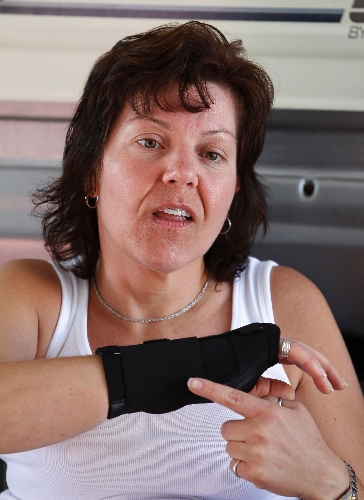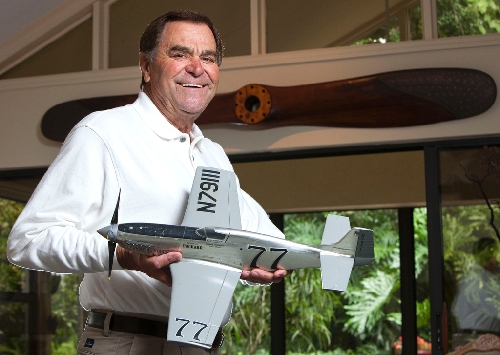Crash victims shared love of aviation
RENO -- They came from every corner to the Nevada desert to watch the nation's premier air race, a daring competition among speed-hungry pilots that pushed the limits of safety. They all had one thing in common: a deep affection for aviation.
One was a wheelchair-using recent college graduate who was thrilled to be at the races. Another was a former airline pilot who owned a vintage airplane. Still another was at his first race, attending it at the urging of his father and brother.
They were among the 10 people who died when one of the planes in the race, a World War II-era P-51 Mustang fighter plane called "The Galloping Ghost," plunged into the VIP section Friday. The 74-year-old stunt pilot also died in the nation's deadliest air racing disaster.
The shrapnel from the crash sprayed the crowd, leaving dozens more with severed limbs, including fingers, legs and arms.
Since the crash, authorities in Reno have been flooded with calls from around the country, as relatives and friends worried about the whereabouts of spectators. Medical officials used fingerprints and DNA to identify the remains of the victims.
"We've had some emotional calls, and it's because of the uncertainty," said Kathy Jacobs, executive director of the Crisis Call Center in Reno. "It's terrifying for those individuals not to know what has happened to their loved ones."
Four members of a Kansas family were taken to a Reno hospital for serious injuries after the crash.
The matriarch, Cherie Elvin, went missing after the plane hit ground. The injured were her husband, Chuck Elvin; their two sons, Bill and Brian Elvin; and Brian Elvin's wife, Linda. All had lost some part of a leg, according to a website used by the family.
Gary Umscheid, whose daughter, Rachel, is married to Bill Elvin, described Cherie and Chuck Elvin as "very typical Midwestern folks who love family."
"The family has a distinct love of aviation," Umscheid said.
The National Championship Air Races draw thousands to Reno every September to watch military and civilian planes race. Local schools often hold field trips there, and a local sports book takes wagers on the outcomes.
During the races, planes fly wingtip-to-wingtip as low as 50 feet off the ground. The competitors follow an oval path around pylons, with distances and speeds depending on the class of aircraft. Pilots reach speeds up to 500 mph.
On Friday, pilot Jimmy Leeward became the 20th pilot to die at the races since the event began 47 years ago, but the crash was the first at which spectators were killed. Some of the injured described being coated in aviation fuel that burned.
Leeward and his team had modified the plane beyond recognition, taking a full 10 feet off the wingspan and cutting the ailerons -- the back edges of the wings used to turn the aircraft -- by roughly 28 inches.
Leeward was a veteran air racer from Ocala, Fla., who flew in Hollywood movies. His father worked in aviation and taught him the trade. He was married with two adult sons. Leeward loved speeding, on the ground or in the air, and recently had taken up racing cars.
Dan Martin of San Jose, Calif., flew with Leeward on the set of "The Tuskegee Airmen" in 1995. Martin competed in one of the Reno competition's slower races last week and was watching at the time of the crash.
"He could fly just about anything, and he always took a very professional approach to everything he did in aviation," Martin said.
Among the others killed were Sharon Stewart, 47, of Reno; Greg Morcom, 47, of Marysville, Wash.; George Hewitt, 60, and Wendy Hewitt, 57, both of Fort Mohave, Ariz.; Michael Wogan, 22, of Scottsdale, Ariz.; and Regina Bynum, 53, of San Angelo, Texas.
Stewart had nine children, four still alive. She lived with her longtime boyfriend in a Reno trailer home and rarely worked because he preferred she stayed at home while he provided for them.
Dave Haskin, 50, was working with Stewart cleaning trash at the race grounds. When he saw the plane go straight up, he knew something was wrong, he said. Moments later, the plane exploded on the ground.
"There were arms and legs and this guy whose torso got cut in half," Haskin said.
Morcom was visiting the air races for the first time with his father and brother, who had attended many times. Morcom worked for a private fish hatchery for 10 years, then switched to construction. He lived with his parents and took care of them.
"He had really been looking forward to it," said his older brother, Ron Morcom. "He wasn't a pilot, but he would go up with my father in his plane whenever he had a chance."
The Hewitts attended the show with a Washington-based group of vintage airplane owners. George Hewitt flew as a pilot with Air Canada for more than 40 years. The Seattle Times reported that he owned a small post-World War II plane built by the same company that made the model Leeward crashed in Reno.
Bynum's husband, Jerry Bynum, said the couple were enjoying the race from box seats with five friends when the plane crashed about 300 feet away. Regina Bynum was struck in the face and arm by the debris. Everyone else in the group was untouched.
"Why did that one piece seek her out?" her husband, a pilot, said during a phone interview. "I just don't understand it at all, and I don't think I'll ever get an answer."
Regina Bynum was a branch office assistant for an investment company. She had three children from a previous marriage and four grandchildren. She raised goats and Yorkshire terriers.
"She was a very outgoing, very bubbly person," Jerry Bynum said. "She would immediately start talking to strangers like she had known them forever."
Wogan was sitting in an area for wheelchairs with his father when the plane hit the ground. He, like two of his brothers, was diagnosed at an early age with muscular dystrophy and was wheelchair-bound his entire life. He had no way of protecting himself from the flying debris.
"Michael liked to get out and travel, and he was so excited about getting on a plane as part of this trip," his brother, James Wogan, said in a statement.
Michael Wogan studied finance, graduated with honors in May from Arizona State University and didn't consider himself disabled, said Cindy Simonsen, a family friend. He ran his own business and was gearing up to start a new one, she said.
"It was never enough," she said. "He was always going."
The Arizona Republic reported that Wogan's father lost an eye and fingers and suffered facial injuries in the crash.
Wogan's mother turned to her faith, Simonsen said.
"Her comment was that 'Michael is running around now on legs never before used,' " Simonsen said.


















